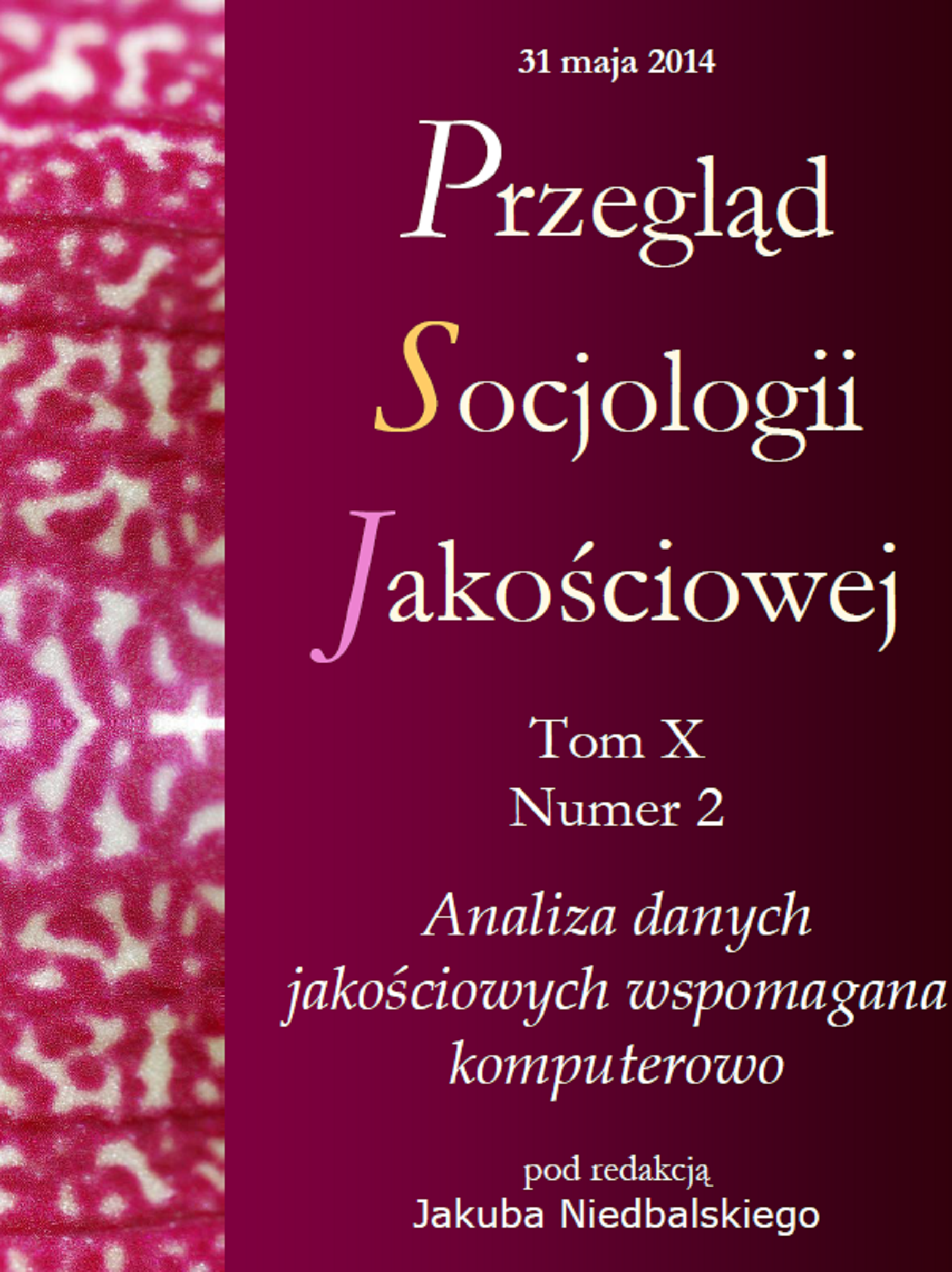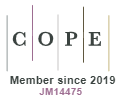Techniki językoznawstwa korpusowego wykorzystywane w krytycznej analizie dyskursu. Przegląd
DOI:
https://doi.org/10.18778/1733-8069.10.2.06Słowa kluczowe:
krytyczna analiza dyskursu, metody korpusowe, analiza kolokacji, analiza słów kluczowych, analiza konkordancjiAbstrakt
Krytyczna analiza dyskursu (KAD) jako nurt z pogranicza socjologii i językoznawstwa skupia się na analizie roli dyskursu w umacnianiu i reprodukowaniu relacji władzy i dominacji, zaś badaniu empirycznemu podlegają przede wszystkim różnego rodzaju teksty. Właśnie koncentrację na tekście uznać można za jedną z przyczyn wzrastającego zainteresowania wykorzystaniem metod językoznawstwa korpusowego w takich analizach. Prezentacji tych metod poświęcony jest niniejszy artykuł. Przedstawione zostaną podstawowe strategie doboru korpusu do badań w ramach KAD oraz najczęściej wykorzystywane metody: analiza frekwencji, analiza słów kluczowych, analiza kolokacji i analiza konkordancji. Zaprezentowane zostaną także przykłady zastosowania poszczególnych metod w różnorodnych tematycznie badaniach. Przegląd metod podsumowany zostanie omówieniem korzyści wypływających z ich zastosowania oraz kosztów, które się z nimi wiążą.
Pobrania
Bibliografia
Albakry Mohammed (2004) U.S. “Friendly Fire” Bombing of Canadian Troops: Analysis of the Investigative Reports. „Critical Inquiry in Language Studies”, vol. 1, no. 3, s. 163–178.
Google Scholar
DOI: https://doi.org/10.1207/s15427595cils0103_3
Alcaraz-Ariza, María Ángeles (2002) Evaluation in English-Medium Medical Book Reviews. „International Journal of English Studies”, vol. 2, no. 1, s. 137–153.
Google Scholar
DOI: https://doi.org/10.6018/ijes/2011/1/137141
Almeida Eugenie P. (2011) Palestinian and Israeli Voices in Five Years of U.S. Newspaper Discourse. „International Journal of Communication”, vol. 5, s. 1586–1605.
Google Scholar
Babbie Earl R. (2003) Badania społeczne w praktyce. Przełożyła Agnieszka Kloskowska-Dudzińska. Warszawa: Wydawnictwo Naukowe PWN.
Google Scholar
Bachmann Ingo (2011) Civil partnership – “gay marriage in all but name”: a corpus-driven analysis of discourses of same-sex relationships in the UK Parliament. „Corpora”, vol. 6, no. 1, s. 77–105.
Google Scholar
DOI: https://doi.org/10.3366/cor.2011.0005
Baker Paul (2006) Using corpora in discourse analysis. London, New York: Continuum.
Google Scholar
DOI: https://doi.org/10.5040/9781350933996
Baker Paul i in. (2008) A useful methodological synergy? Combining critical discourse analysis and corpus linguistics to examine discourses of refugees and asylum seekers in the UK Press. „Discourse & Society”, vol. 19, no. 3, s. 273–306.
Google Scholar
DOI: https://doi.org/10.1177/0957926508088962
Bondi Marina, Scott Mike (2010) Keyness in texts. Amsterdam, Philadelphia: John Benjamins Publishing.
Google Scholar
DOI: https://doi.org/10.1075/scl.41
Breeze Ruth (2011) Critical Discourse Analysis and Its Critics. „Pragmatics”, vol. 21, no. 4, s. 493–525.
Google Scholar
DOI: https://doi.org/10.1075/prag.21.4.01bre
Brown Penelope, Levison Stephen C. (1987) Politeness. Some universals in language usage. Cambridge: Cambridge University Press.
Google Scholar
DOI: https://doi.org/10.1017/CBO9780511813085
Chen Lily (2012) Reporting news in China: Evaluation as an indicator of change in the China Daily. „China Information”, vol. 26, no. 3, s. 303–329.
Google Scholar
DOI: https://doi.org/10.1177/0920203X12456338
Degano Chiara (2007) Dissociation and Presupposition in Discourse: A Corpus Study. „Argumentation”, vol. 21, no. 4, s. 361–378.
Google Scholar
DOI: https://doi.org/10.1007/s10503-007-9058-7
Don Zuraidah Mohd, Knowles Gerry, Fatt Choong Kwai (2010) Nationhood and Malaysian identity: a corpus-based approach. „Text & Talk – An Interdisciplinary Journal of Language, Discourse & Communication Studies”, vol. 30, no. 3, s. 267–287.
Google Scholar
DOI: https://doi.org/10.1515/text.2010.014
Edwards Geraint O. (2012) A comparative discourse analysis of the construction of ‘in-groups’ in the 2005 and 2010 manifestos of the British National Party. „Discourse & Society”, vol. 23, no. 3, s. 245–258.
Google Scholar
DOI: https://doi.org/10.1177/0957926511433477
Fabiszak Małgorzata, Hebda Anna, Konat Barbara (2012) Dichotomy between private and public experience: The case of Polish wierzyć ‘believe’. „Selected Papers from UK-CLA Meetings”, vol. 1, s. 164–176.
Google Scholar
Forchtner Bernhard, Kolvraa Christoffer (2012) Narrating a ‘new Europe’: From ‘bitter past’ to self-righteousness? „Discourse & Society”, vol. 23, no. 4, s. 377–400.
Google Scholar
DOI: https://doi.org/10.1177/0957926512441108
Freake Rachelle, Gentil Guillaume, Sheyholislami Jaffer (2010) A bilingual corpus-assisted discourse study of the construction of nationhood and belonging in Quebec. „Discourse & Society”, vol. 22, no. 1, s. 21–47.
Google Scholar
DOI: https://doi.org/10.1177/0957926510382842
Gabrielatos Costas, Baker Paul (2008) Fleeing, Sneaking, Flooding: A Corpus Analysis of Discursive Constructions of Refugees and Asylum Seekers in the UK Press, 1996-2005. „Journal of English Linguistics”, vol. 36, no. 1, s. 5–38.
Google Scholar
DOI: https://doi.org/10.1177/0075424207311247
Gabrielatos Costas., Marchi Anna (2011) Keyness: Matching metrics to definitions. Refereat zaprezentowany podczas Theoretical-methodological challenges in corpus approaches to discourse studies – and some ways of addressing them, 5 listopada, Portsmouth, Anglia.
Google Scholar
Gabrielatos Costas, Marchi Anna (2012) Keyness: Appropriate metrics and practical issues. Refereat zaprezentowany podczas CADS International Conference 2012, 13–14 września, Bologna, Włochy.
Google Scholar
Głowińska Katarzyna, Przepiórkowski Adam (2010) The Design of Syntactic Annotation Levels in the National Corpus of Polish [dostęp 15 stycznia 2014 r.]. Dostępny w Internecie http://nlp.ipipan.waw.pl/~adamp/Papers/2010-lrec-kg/lrec-nkjp_0324.pdf
Google Scholar
Gregory Ian N. (2008) Different Places, Different Stories: Infant Mortality Decline in England and Wales, 1851–1911. „Annals of the Association of American Geographers”, vol. 98, no. 4, s. 773–794.
Google Scholar
DOI: https://doi.org/10.1080/00045600802224406
Gries Stefan Thomas (2009) Quantitative corpus linguistics with R. A practical introduction. New York: Routledge.
Google Scholar
DOI: https://doi.org/10.4324/9780203880920
Gries Stefan Thomas (2010) Useful statistics for corpus linguistics [w:] Aquilino Sánchez, Moisés Almela, eds., A mosaic of corpus linguistics: selected approaches. Frankfurt am Main: Peter Lang, s. 269–291.
Google Scholar
Halliday Michael, Matthiessen Christian (2004) An introduction to functional grammar. London, New York: Arnold.
Google Scholar
Hamilton Craig, Adolphs Svenja, Nerlich Brigitte (2007) The meanings of ‘risk’: a view from corpus linguistics. „Discourse & Society”, vol. 18, no. 2, s. 163–181.
Google Scholar
DOI: https://doi.org/10.1177/0957926507073374
Hardt-Mautner Gerlinde (1995) ‘Only Connect.’ Critical Discourse Analysis and Corpus Linguistics [dostęp: 20 maja 2012 r.]. Dostępny w Internecie http://ucrel.lancs.ac.uk/papers/techpaper/vol6.pdf
Google Scholar
Hebda Anna (2011) Onde and envy: A diachronic cognitive approach [w:] Jacek Fisiak, ed., Studies in Old and Middle English. Frankfurt am Main: Peter Lang, s. 107–126.
Google Scholar
Herbel-Eisenmann Beth, Wagner David (2010) Appraising lexical bundles in mathematics classroom discourse: obligation and choice. „Educ Stud Math”, vol. 75, no. 1, s. 43–63.
Google Scholar
DOI: https://doi.org/10.1007/s10649-010-9240-y
Hidalgo Tenorio Encarnacion (2011) Critical Discourse Analysis, An overview. „Nordic Journal of English Studies”, vol. 10, no. 1, s. 184–210.
Google Scholar
DOI: https://doi.org/10.35360/njes.247
Kamasa Victoria (2013a) Naming “In Vitro Fertilization”: Critical Discourse Analysis of the Polish Catholic Church’s Official Documents. „Procedia – Social and Behavioral Sciences”, vol. 95, s. 154–159.
Google Scholar
DOI: https://doi.org/10.1016/j.sbspro.2013.10.634
Kamasa Victoria (2013b) Rodzina w dyskursie Polskiego Kościoła Katolickiego. Badania korpusowe z perspektywy Krytycznej Analizy Dyskursu. „Socjolingwistyka”, vol. 27, s. 139–152.
Google Scholar
Koller Veronika (2004) Businesswomen and war metaphors: ‘Possessive, jealous and pugnacious’? „Journal of Sociolinguistics”, vol. 8, no. 1, s. 3–22.
Google Scholar
DOI: https://doi.org/10.1111/j.1467-9841.2004.00249.x
Lischinsky Alon (2011) In times of crisis: a corpus approach to the construction of the global financial crisis in annual reports. „Critical Discourse Studies”, vol. 8, no. 3, s. 153–168.
Google Scholar
DOI: https://doi.org/10.1080/17405904.2011.589231
Louw Bill (1993) Irony in the Text or Insincerity in the Writer? The Diagnostic Potential of Semantic Prosodies [w:] M. Baker, ed., Text and Technology. Amsterdam: John Benjamins, s. 157–176.
Google Scholar
DOI: https://doi.org/10.1075/z.64.11lou
Lukac Morana (2011) Down to the bone: A corpus-based critical discourse analysis of pro-eating disorder blogs. „Jezikoslovlje”, vol. 12.2, s. 187–209.
Google Scholar
Marling Raili (2010) The Intimidating Other: Feminist Critical Discourse Analysis of the Representation of Feminism in Estonian Print Media. „NORA – Nordic Journal of Feminist and Gender Research”, vol. 18, no. 1, s. 7–19.
Google Scholar
DOI: https://doi.org/10.1080/08038741003626767
Mautner Gerlinde (2005) The Entrepreneurial University. „Critical Discourse Studies”, vol. 2, no. 2, s. 95–120.
Google Scholar
DOI: https://doi.org/10.1080/17405900500283540
Mautner Gerlinde (2007) Mining large corpora for social information: The case of elderly. „Language in Society”, vol. 36, no. 1, s. 51–72.
Google Scholar
DOI: https://doi.org/10.1017/S0047404507070030
McEnery Tony, Wilson Andrew (2001) Corpus linguistics. An introduction. Edinburgh: Edinburgh University Press.
Google Scholar
Miechowicz-Mathiasen Katarzyna, Scheffler Paweł (2008) A corpus-based analysis of the Polish verb podobać się [w:] Jacek Witkoś, ed.,
Google Scholar
Elements of Slavic and Germanic grammars: a comparative view. Papers on topical issues in syntax and morphosyntax. Frankfurt, Berlin, Bern, Brussels, New York, Oxford, Vienna: Peter Lang, s. 89–111.
Google Scholar
Młodzki Rafał, Przepiórkowski Adam (2009) The WSD Development Environment [w:] Zygmunt Vetulani, ed., Proceedings of LTC 2009, s. 185–189 [dostęp 15 stycznia 2014 r.]. Dostępny w Internecie http://nlp.ipipan.waw.pl/~adamp/Papers/2009--ltc-wsd/ltc-034-lodzki.pdf
Google Scholar
Mohamad Subakir Mohd Yasin i in. (2012) Linguistic Sexism In Qatari Primary Mathematics Textbooks. „GEMA Online™ Journal of Language Studies”, vol. 12, no. 1, s. 53–68.
Google Scholar
Mulderrig Jane (2011) Manufacturing Consent: A corpus-based critical discourse analysis of New Labour’s educational governance. „Educational Philosophy and Theory”, vol. 43, no. 6, s. 562–578.
Google Scholar
DOI: https://doi.org/10.1111/j.1469-5812.2010.00723.x
O’Halloran Kieran (2009) Inferencing and cultural reproduction: a corpus-based critical discourse analysis. „Text & Talk – An Interdisciplinary Journal of Language, Discourse Communication Studies”, vol. 29, no. 1, s. 21–51.
Google Scholar
DOI: https://doi.org/10.1515/TEXT.2009.002
Orpin Debbie (2005) Corpus Linguistics and Critical Discourse Analysis. Examining the ideology of sleaze. „International Journal of Corpus Linguistics”, vol. 10:1, s. 37–61.
Google Scholar
DOI: https://doi.org/10.1075/ijcl.10.1.03orp
Oster Ulrike (2010) Using corpus methodology for semantic and pragmatic analyses: What can corpora tell us about the linguistic expression of emotions? „Cognitive Linguistics”, vol. 21, no. 4, s. 727–763.
Google Scholar
DOI: https://doi.org/10.1515/cogl.2010.023
Prentice Sheryl (2010) Using automated semantic tagging in Critical Discourse Analysis: A case study on Scottish independence from a Scottish nationalist perspective. „Discourse & Society”, vol. 21, no. 4, s. 405–437.
Google Scholar
DOI: https://doi.org/10.1177/0957926510366198
Przepiórkowski Adam i in. (2009) Narodowy Korpus Języka Polskiego. „Biuletyn Polskiego Towarzystwa Językoznawczego”, t. 65, s. 47–56.
Google Scholar
Rayson Paul (2009) Wmatrix: a web-based corpus processing environment, Computing Department, Lancaster University, dostępny na stronie http://ucrel.lancs.ac.uk/wmatrix
Google Scholar
Rogers Rebecca i in. (2005) Critical Discourse Analysis in Education: A Review of the Literature. „Review of Educational Research”, vol. 75, no. 3, s. 365–416.
Google Scholar
DOI: https://doi.org/10.3102/00346543075003365
Salama Amir H.Y. (2011) Ideological collocation and the recontexualization of Wahhabi-Saudi Islam post-9/11: A synergy of corpus linguistics and critical discourse analysis. „Discourse & Society”, vol. 22, no. 3, s. 315–342.
Google Scholar
DOI: https://doi.org/10.1177/0957926510395445
Schmidt Filip, Skowrońska Marta (2006) Człowiek w sieci przedmiotów. Socjologiczna analiza roli i znaczenia przedmiotów w przestrzeni domowej [w:] Jacek Kowalewski, Wojciech Piasek, Marek Śliwa, red., Rzeczy i ludzie. Humanistyka wobec materialności. Olsztyn: Colloquia Humaniorum, s. 197–222.
Google Scholar
Scott Mike (2013a) WordSmith Tools Help [dostęp 20 sierpnia 2013 r.]. Dostępny w Internecie http://www.lexically.net/downloads/version6/HTML/index.html?keywords_info.htm
Google Scholar
Scott Mike (2013b) WordSmith Tools. Liverpool: Lexical Analysis Software.
Google Scholar
Stubbs Michael (1997) Whorf’s Children: Critical comments on Critical Discourse Analysis (CDA) [w:] Ann Ryan, Alison Wray, eds., Evolving models of language. Papers from the annual meeting of the British Association for Applied Linguistics held at the University of Wales, Swansea, September 1996. Clevedon: British Association for Applied Linguistics, s. 100–116.
Google Scholar
Stubbs Michael (2001)Words and phrases. Corpus studies of lexical semantics. Oxford, Malden: Blackwell Publishers.
Google Scholar
Subtirelu Nicholas Close (2013) ‘English… it’s part of our blood’: Ideologies of language and nation in United States Congressional discourse. „Journal of Sociolinguistics”, vol. 17, no. 1, s. 37–65.
Google Scholar
DOI: https://doi.org/10.1111/josl.12016
van Dijk Teun A. (2001) Multidisciplinary CDA: a plea for diversity [w:] Ruth Wodak, Michael Meyer, eds., Methods of critical discourse analysis. London: Sage, s. 95–120.
Google Scholar
DOI: https://doi.org/10.4135/9780857028020.n5
van Leeuwen Theo (2008) Discourse and practice. New tools for critical discourse analysis. Oxford, New York: Oxford University Press.
Google Scholar
Weninger Csilla (2010) The lexico-grammar of partnerships: corpus patterns of facilitated agency. „Text & Talk – An Interdisciplinary Journal of Language, Discourse & Communication Studies”, vol. 30, no. 5, s. 591–613.
Google Scholar
DOI: https://doi.org/10.1515/text.2010.029
Whitsitt Sam (2005) A critique of the concept of semantic prosody. „International Journal of Corpus Linguistics”, vol. 10, no. 3, s. 283–305.
Google Scholar
DOI: https://doi.org/10.1075/ijcl.10.3.01whi
Wodak Ruth (2001) The discourse-historical approach [w:] Ruth Wodak, Michael Meyer, eds., Methods of critical discourse analysis. London: Sage, s. 63–94.
Google Scholar
DOI: https://doi.org/10.4135/9780857028020.n4
Pobrania
Opublikowane
Jak cytować
Numer
Dział
Licencja

Utwór dostępny jest na licencji Creative Commons Uznanie autorstwa – Użycie niekomercyjne – Bez utworów zależnych 4.0 Międzynarodowe.














